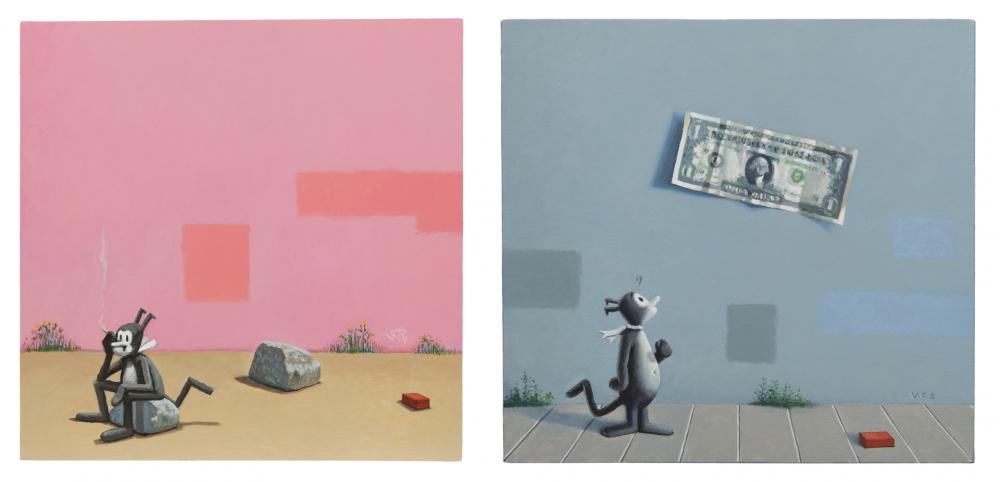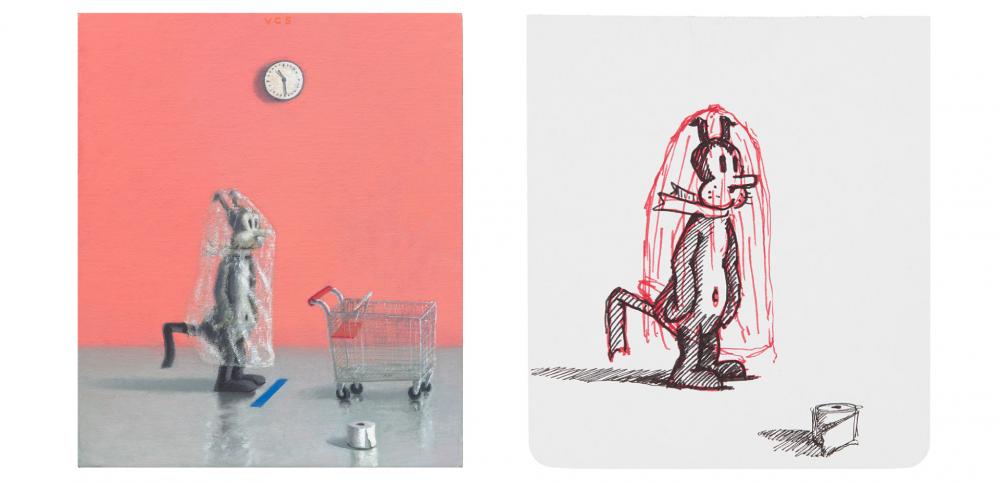The words “Don’t Worry” loom large at the top of an industrial building that dwarfs a small figure, who, despite standing with its back to us, conveys a sense of bewilderment.

The figure is a 2020 version of Krazy Kat, the protagonist of the comic created by George Herriman in the early 20th century that is beloved by many artists, including Philip Guston and Jess. Wayne Thiebaud has passed along his love of Krazy Kat over the years to his students, including Sumner. As Grace Munakata recounts in a video interview, Thiebaud compared Herriman to Francisco Goya (1746–1828), emphasizing the importance of Herriman’s work and elevating him and his genre — comics — to a status usually accorded only to the great painters of art history.
Vonn Sumner’s 21st century Krazy is not a mere reproduction of the early comic strip. The always gender-fluid Krazy, whose pronouns varied from strip to strip, felt to Sumner like an apt persona for this moment, where explorations of identity have become more mainstream. In the original comic, Krazy, a black cat, is hopelessly in love with Ignatz, a white mouse, who wants nothing to do with Krazy, and illustrates this by throwing a brick at Krazy every chance he gets. Krazy, ever the innocent, interprets the brick as a sign of love.

Both Existential Crisis and Golla! A Dolla? feature the small, red brick on the ground — evidence of Krazy’s unrelenting ardor. Sumner has described this series of paintings as a love letter to his teacher and mentor, Thiebaud. In that sense, the brick could stand in for Sumner’s affection for his longtime teacher. Golla! A Dolla? also includes a life-size dollar bill, an homage to one of Thiebaud’s favorite class assignments: draw or paint a dollar bill so realistically that one wouldn’t be able to tell an actual bill from the artistically rendered one. In this context, it also emphasizes capitalist structures in our society. The bill floats high on the wall, appearing like a sign from God. This connection is made more explicit in a preparatory sketch, KK & Dollar Bill.

Sumner’s tenderly humorous, contemporary take on Krazy can also be seen in Watching a Dumpster Fire, Krazy Mask, and Shopping, where Krazy dutifully waits behind a line of blue tape on the ground, clad in protective gear.

Left: Vonn Cummings Sumner, Shopping, 2020. Oil on canvas over panel, 14 x 12 in. (35.6 x 30.5 cm).
Right: untitled sketch. Courtesy of the artist. © Vonn Cummings Sumner.
On the ground sits a roll of toilet paper, a study in the fundamentals of painting and drawing: the perfect circle of the top, bottom and cardboard center of the roll; the shadow cast by the toilet paper; and the colors that make up the reflection on the floor. The preparatory sketch breaks it down even further into a study of form, line and shadow. At the same time, the toilet paper — in addition to the protective gear and tape line — have become potent symbols of the COVID-19 world. This painting cuts to the core of how going to the grocery store — an activity we once took for granted — has, during a global pandemic, become something both sacred and dangerous.

This sense of foreboding about the world shows up in the many sketches Sumner makes in preparation for the finished paintings — sketches that show the importance of a regular art practice. K.K. In Bed At Night On Phone, captures the anxiety of doom scrolling night after night, but also the construction of perspective through crosshatched lines. K.K. Staring at Cell Phone (Walk Sign is On) captures a similar mix of anxiety and distraction in a scene composed of lines and shading.

Left: Vonn Cummings Sumner, Elephant in the Room II, 2020. Oil on canvas over panel, 15 x 16 in. (38.1 x 40.6 cm). Courtesyof the artist. © Vonn Cummings Sumner. Photo: Cleber Bonato. Right: Vonn Cummings Sumner, Elephant sketch.
Full of humor, melancholy and pathos, Krazy’s world as constructed by Sumner makes us want to laugh, cry and shrug our shoulders in bewilderment along with Krazy, who aptly embodies the painful historic moment. In Elephant in the Room II, Krazy peeks out the window, turning away from an elephant whose body, and metaphorical presence, fills the space of the room. In the preparatory sketch, KK w/ Elephant in the Room, Sumner places Krazy in the room, sitting on the floor and staring gloomily towards the elephant. By turning Krazy away in the final version, Sumner allows the cat to remain innocent for a moment longer. In a sense, we are all Krazy, looking for an escape outside the prison we find ourselves in — be it the confines of racial or gender norms, the horrors of a global pandemic, or structures of oppression that cannot be tolerated.
Susie Kantor, Associate Curator








